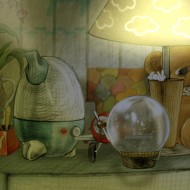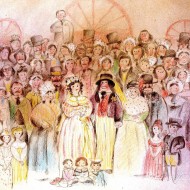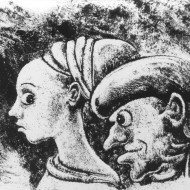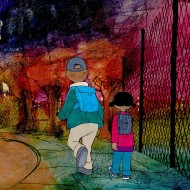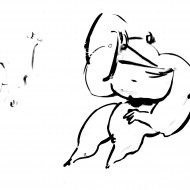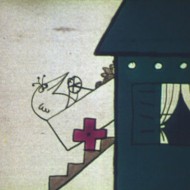The Big Sleep
Nag Ansorge (1925-2013)
Nag Ansorge has concluded the long film of his life. He left us with a rich body of diverse work, essentially created in symbiotic complicity with his wife Gisèle. The couple earned worldwide recognition with ten short films, animated with blackened quartz sand.
Their encounter with the works of Czech master Ji?í Trnka's revealed the universe of animation to them, and soon after they took their first steps with puppets of their own design. They soon earned success in amateur circles, which encouraged them to become professional filmmakers and set up their own studio in a small house outside Lausanne. Even though their debut professional film, presented at the first International Animation Film Festival in Annecy in 1960, created little enthusiasm, they did gain some recognition from the professional community.
Bowing to reality, they put the puppets and personal projects aside for the time and Gisèle went back to work as a pharmacist while Nag in turn, by means of newsreels and technical documentaries, worked his way into the vast field of commissioned film. Thanks to this bread-and-butter work, they discovered the material of their destiny: for a film about heart defects, they came up with the idea to use sand for the animation of the circulating blood. When their first film made exclusively with black sand, The Ravens, premiered at Annecy 1967, it instantly earned critical acclaim. They followed it with Fantasmatic (1969), Anima (1977) and their last film together, Sabbath (1991).
For Swiss animation, Nag's most significant commitment was his participation with the Swiss Animator's Group or Asifa Switzerland as secretary general, and later as president for almost 25 years.
ROLF BÄCHLER
Filmmaker and freelance animator
Frédéric Back (1924-2013)
Filmmaker, but also painter, illustrator, naturalist and environmentalist, Frédéric Back made his mark on animation history.
Frédéric Back's most well-known films, often sources of influence for many renowned filmmakers (John Lasseter, Hayao Miyazaki, Isao Takahata, Jacques-Rémy Girerd, to name a few), were awarded in Hollywood, Annecy and elsewhere. The director's commitment to the preservation of nature shaped his work and gave him inspiration. In this respect, his reputation crossed the boundaries of animation's small circle. He often abandoned the studio in order to support ecological and peaceful causes, responding "present" when his authority was requested.
His work came during a special moment in animation history. After having finished Crac ! in 1981, Back worked relentlessly on his masterpiece, The Man Who Planted Trees (1987), while John Lasseter was presenting The Adventures of André and Wally B. (1984) then Luxo Jr. (1986). At the end of the 1980s, during the early production stages of The Mighty River (1993), Disney introduced CGI at their studios. While computer graphics were paving their way, Back reinvented traditional animation on cellulose to draw out new styles. His challenge was to make it possible to convincingly convey the beauty of nature. Driven by a peaceful strength and persuaded by the nobility and justice of his cause, Frédéric Back left an eloquent body of work that deserves respect.
MARCO DE BLOIS
Cinémathèque québécoise/Les Sommets du cinéma d’animation
Xavier JULLIOT (1965-2013)
Xavier Julliot has gone to join the Eternal Land of the Snowy Mountains.
After studies in Computer Science and Management, Xavier Julliot was set for a career in administration till he met up with producer Claude Huardeau in 1987, who at the time was developing a software for 2D animation. He then started at the production company Label 35, based in Créteil, and worked on his first animated series, Sharky & Georges, entirely produced in France and for which he and other novices from the crew followed a training course at the Gobelins school. Over the next four years he discovered and worked in all the different jobs making up 2D animation, ranging from writing to 35 mm filming.
Since the great Label 35 adventure ended in 1991, Julliot studied Layout Design and worked for an advertising company. However, he soon became nostalgic for his previous job and the teamwork it offered, and decided to join a number of his former colleagues to work on the feature A Goofy Movie at the Walt Disney Feature studios in Montreuil.
1995 saw him beginning his collaboration with La Fabrique, set up in the Cévennes by founder Jean-François Laguionie. His first project there was the feature Le Château des singes, followed by working as technical director, production director and producer/studio director on three other features, L’Île de Black Mór, Go West: A Lucky Luke Adventure and Eleanor's Secret, along with various shorts, TV films and commercials. In 2009, he took over the reins of the studio from Jean-François Laguionie, as Director and Producer.
Marie-Aline PUTZ-PERRIER
CITIA
Michael Sporn (1946-2014)
Tireless traditionalist of hand-drawn animation, Michael Sporn used a style that was both wonderfully adaptable and distinctly recognisable.
Drawn to the world of animation from an early age, Michael Sporn related in an interview with the Los Angeles Times that at the age of four he remembers having said the word "cartoon" to his mother in a way that spoke volumes. Due to a troubled and prematurely interrupted childhood, he later became the creator of many films dealing with the family.
After studies in Fine Arts at the New York Institute of Technology, he served 5 years in the US Navy and continued to study art and animation by correspondence. In 1972, he started out working with John Hubley and London-based director Richard Williams, before setting up his own studio in New York in 1980.
He made a number of films adapted from popular children's books, including Lyle Lyle Crocodile (1987) and The Man Who Walked Between the Towers (2005), that show off his capacity to change style and reflect the original illustrator. Alongside these adaptations, his personal films were targeted to an older public and had a recognisable style, often dealing with subjects about society, like the dark short Champagne (1997), rewarded by a host of prizes, or Whitewash (1994).
The guiding line that runs through Michael Sporn's films is his constant and tireless resolution to never use technology, but maintain a direct link between the artist and the paper, concentrating all his art into drawings that were done by hand, in a style that was simple yet very animated.
Marie-Aline PUTZ-PERRIER
CITIA
Jimmy Teruaki MURAKAMI (1933-2014)
The amazing life of an "animation globe-trotter".
The life and career of Jimmy T. Murakami is one of the most amazing ever! Born in California, placed with his family in an internment camp during the Second World War and later trained at Chouinard Art Institute in Los Angeles, he started out at the United Production of America (UPA), following on with a brief stint at Toei Animation, in Tokyo, before working several years in London at John Coates and John Dunning's studio,TVC. Back in Los Angeles in 1965, he associated with Fred Wolf to create Murakami-Wolf, and made his first major film, Breath (1967), an allegory of life and social relationships that won him the Annecy Grand Prix. During this period, he also produced the Oscar nominated short Magic Pear Tree (1968), before moving his company to Ireland in 1971 where he ably contributed to establishing the animation industry there.
1981 saw him supervising the making of The Snowman, the adaptation of the book by Raymond Briggs produced by John Coates and once again Oscar nominated. He worked again with Briggs and Coates in 1986 to make his master work, the feature When the Wind Blows, a poignant tale about a nuclear attack on Great Britain, and the following year, his studio began producing the hit series Teenage Mutant Ninja Turtles. The last major work by this "animation globe-trotter" (an expression given to him by Giannalberto Bendazzi) was the feature adapted from a novel by Dickens, Christmas Carol: the Movie (2001).
MARCEL JEAN
CITIA
René BORG (1933-2014)
A rare bird has flown. Father to the Shadoks and an eclectic and prolific artist, René Borg marked a whole generation and served as a model for many figures from the world of animation.
René Borg started out as an in-betweener at Jean Image at the end of the 50s. Employed in the Research department at the ORTF, he worked on the development of the animograph that was invented by Jean Dejoux. This was the machine that he and Jacques Rouxel used to make Les Shadoks, the famous animated series that divided French viewers in 1968, and has left such cult lines as "Why be simple, when you could be complicated?". René Borg was also father to Nono the little robot in Ulysses 31, and Zoom the white dolphin, a character that was so popular that it became the mascot of a brand of chocolate! Author, co-author, director, animation director or advisor and artistic director, Borg also played a part in many series throughout the 80s including Wattoo Wattoo, Clementine and Once Upon a Time...Man.
He was a respected figure in the animation world as he always tried to promote its vitality and creative richness. Amongst his commitments to the industry, he was a member of the board and organisation of the Journées internationales du cinéma d'animation (forerunner to the present Annecy Festival), and remained a pioneer of Franco-Japanese cooperation as well as founding the institut de formation européen de dessin animé. Many figures from animation, like Jean-Yves Raimbaud (Oggy and the Cockroaches) or Bruno Bianchi (Inspector Gadget), consider him as a mentor, and his legendary characters and offbeat humour are remembered by generations.
MARIE-ALINE PUTZ-PERRIER, ANNAH TIPREZ
CITIA
